2011 Media Streamer Roundup : Netgear NTV550, A.C.Ryan PlayOn!HD2 and the Boxee Box
by Ganesh T S on November 20, 2011 10:32 AM EST- Posted in
- Home Theater
- Media Streamer
- NetGear
- Boxee Box
We had an initial look at the A.C.Ryan PlayOn!HD2 back in February. The Boxee Box was reviewed in detail last November. Both the pieces had coverage of the hardware features in detail. In this section, we will look at the internals of the NTV550 in detail. Following this, we will have a comparison of the build of the three units and some notes on the remote controllers.
Netgear NTV550 Specifics
Upon initial unboxing, the NTV550's industrial design appears a bit unwieldy. The bulging top with a ventilation slot doesn't seem to quite fit in a home theater setup. Thankfully, a vertical mounting aid is also provided. A little bit of vertical clearance is needed. Once set in this configuration, the unit blends in quite nicely (except for the white coloured USB port which sticks out in the middle of the front panel). The gallery below presents selected unboxing pictures and some shots of the internal board.
The NTV550 is fanless and the board is well laid out (no clustered components). The ventilation slots directly above the SMP8642 make sure that the unit doesn't get unduly hot. The remote controller is the best part of the whole package. We will discuss that in detail in a later subsection.
Build
Out of the three units being considered today, only the A.C.Ryan PlayOn!HD2 has an internal 3.5" hard disk slot. This make the unit slightly bigger than the rest. We have seen comments on the build quality of the A.C.Ryan PlayOn!HD2 and the Boxee Box in previous pieces. In this subsection, we will take a look at the units in one place.
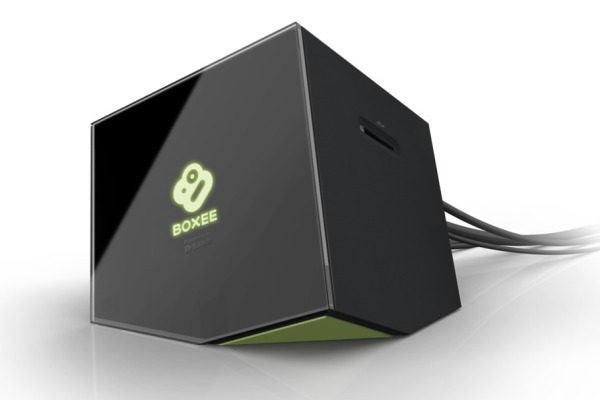
The Boxee Box stands out for its odd-ball design. A small fan running at high speed inside it also made the unit the noisiest of the three.
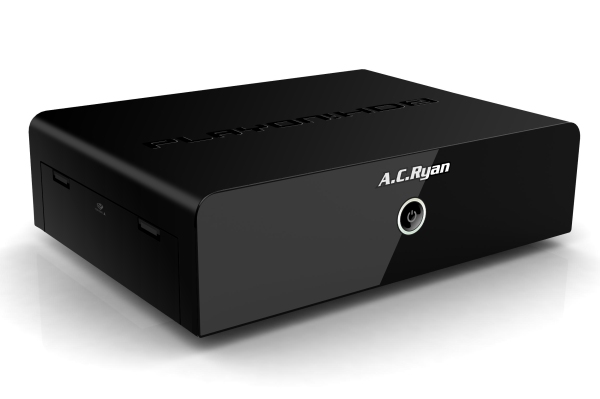
The PlayOn!HD2 needs a fan because of the internal hard disk. However, the fan is not as small as that of the Boxee Box. The A.C.Ryan unit can also act as a DAS (with USB 3.0 connectivity) and a NAS (thanks to its Ethernet port).
The NTV550 can expose the USB drives connected to it as shares on the network. It has a SD card slot, 2 USB 2.0 ports and an eSATA port. The Boxee Box has a SD card slot and 2 USB 2.0 ports.
All the three units use a plastic chassis and the finish is nothing to write home about. In terms of distracting front lighting, the A.C.Ryan PlayOn!HD2 is the most at fault. The front panel of the unit has a ring of light below the logo. In standby mode, this is red. In active operation, it is white. Since the remote controller needs direct line of sight, this ring of light is indeed distracting. The Boxee Box has the Boxee logo on one side of the heptahedron. This side can be fully turned away from the line of sight. If necessary, the unit can also be completely hidden inside a closet because the remote controller is not IR based, but RF. The Boxee logo lights up in bright green when the unit is active. In sleep mode, the intensity of the light goes down quite a bit. The NTV 550 has a small LED at the bottom right (when placed flat on its base) / top right (when placed vertically) beneath the power button. It is green when active and amber in standby mode.
Remote Controller
The remote bundled with the Boxee Box tends to elicit varied responses from users. While some people love the remote with the mini keyboard at the back, others hate it for the lack of buttons tied to specific functionality (like choosing subtitle or audio tracks).
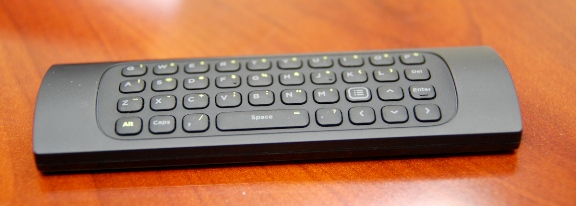
The remotes bundled with the PlayOn!HD2 and the NTV550 are more in line with what consumers are already used to. However, that is where the similarity stops. While the NTV550 remote is ergonomic and feels solid in the hand, the PlayOn!HD2 remote feels cheap. The keys are flimsy and the layout is not intuitive.
Thankfully, each screen in the GUI has pointers on the functionality mapped to different keys. In addition to these drawbacks, the keys are way too sensitive, and a single key press often translated into multiple ones. Like the NTV550, one has to rely on the virtual on-screen keyboard for typing share names / passwords / search for videos on YouTube etc. with the remote. This is one drawback that the Boxee Box seems to have solved well, in our opinion.
The NTV550 remote further earns our praise for having an automatic 'backlight' mode for usage in environments where the display is often the only source of light.
IP Control
Many media streamers with networking capabilities offer some sort of web remote / IP control capability. All three streamers being considered today have some flavour of control over an IP network. For the Boxee Box, we have an Android remote that replicates the functionality of the hardware remote. Control of the unit over a web browser is also possible. Unfortunately, the Boxee Box's IP control mechanisms don't offer any additional advantages over the hardware one.
The A.C.Ryan PlayOn!HD2 has a rudimentary web interface which can reached at http://<IP of the POHD2>:1024. It offers all the capabilities of the hardware remote over three different screens. In addition to that, we also have a playlist view and information on the internal hard disk / attached USB drives. This web remote can also be viewed on smartphones / tablets which are on Wi-Fi and connected in the same LAN. Just like the hardware remote, the IP remote is also pretty cluttered. We have seen better web remotes for Realtek units (for example, the web remote of the TViX Slim S1 was much better).
The NTV550 also has a web remote which can be reached by accessing the IP of the unit over the web browser. The interface is not as good as the hardware remote, but it does offer nice additions such as the ability to choose the next item to be played from the library. This way, it can be used as a music player without having to turn on the display. Another important advantage of the NTV550 is the availability of a TCP remote interface for home automation uses. These codes have also enabled creation of an iOS remote.
The NTV550 is simply one of the best built / equipped media streamers we have seen in our labs. Can it build upon the favourable initial impressions we have? We will see in the remaining sections.








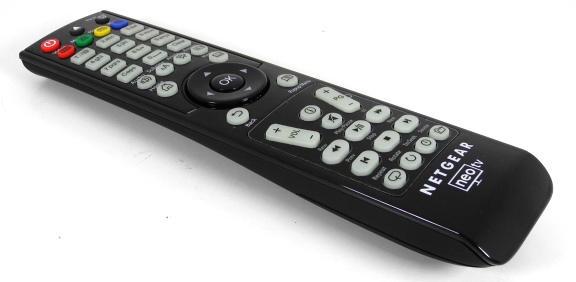

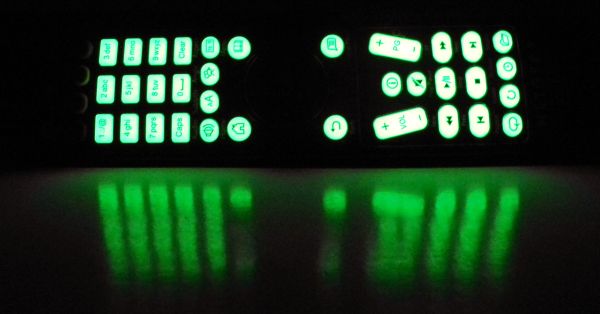




















43 Comments
View All Comments
slyck - Tuesday, November 22, 2011 - link
D-LINK.... the only reason I need to never purchase a Boxee Box.Master_Sigma - Monday, November 21, 2011 - link
Do any of these devices support playback of 10-bit h.264 encodes? I watch alot of anime fansubs and that community has already started moving over to that standard (most NEW fansubs being released nowadays uses 10-bit encoding). My PC can play them fine but I was wondering if there was an off-the-shelf playback device out now that supports them or if I would buy/build a little HTPC, like the ZOTAC Zbox Nano (hopefully with Llano), to do the job.ganeshts - Monday, November 21, 2011 - link
Please look in the Video Codecs Compatibility section under H.264 ; Both Boxee Box and NTV550 play such videos with a blank screen. The POHD2 plays with blocking artifacts. You have to rely on PC for playback of such streams for another year or so (at the least)Master_Sigma - Monday, November 21, 2011 - link
Herp, derp. That's what I get for not reading. Thanks!Nogib - Wednesday, November 23, 2011 - link
Well if those fansubbers weren't complete elitist dicks we wouldn't have this problem. I've loved being able to play 8-bit h.264 encodes on my WDTV Live Plus as well as my netbook (AMD Ontario acceleration is flawless!). But no, can't run this 10-bit garbage on those. Instead of waiting for proper hardware support, fansubbers assumed we all either have HTPCs or love to sit at a computer desk to watch shows. And once one group started doing it the others all followed suit to make sure their e-penis measured up.You can tell I'm only slightly bitter about them changing from 8-bit to 10-bit when there is zero benefit....
chrnochime - Tuesday, December 6, 2011 - link
They do it for free. Don't like it? Go learn Japanese and not have to rely on fansubber to feed your anime needs. Why are you whining about something that you get for free anyway?geniekid - Monday, November 21, 2011 - link
As others above me have said, it looks like an HTPC is still the most capable media center. That said, for the prices of these three alternatives, I would be hard pressed to recommend building an HTPC unless there's some functionality you just can't live without or you're a hobbyist like me :)cjs150 - Monday, November 21, 2011 - link
And a great summary of the state of the marketWhich, for media streamers, sucks.
These are not consumer grade devices and the rate of progress is such that I doubt they ever will be.
On the other hand it is now possible to build or buy a PC that doubles as a proper part of an AV system, that works well and gets better and better. Problem is it takes a bit of work to get Windows 7, XBMC or whatever OS you prefer, to work they way you want.
Zotac nano AD10 is a fantastic bit of kit (please lose the fan though) and close to perfect given its very small size or if you want something larger, AMD Motherboards are a great start and there are some really nice cases out there (for example love look of Wesena, just not convinced by build quality/design)
Sadly you get what you pay for
thudo - Monday, November 21, 2011 - link
http://www.pivosgroup.com/I own this and its quite fantastic for $99 and getting GREAT reviews. Devs are also the only in the biz to rapidly response to suggestions from the customer. Sure its NOT perfect but it works quite well.
Maybe it was too new (Oct 03, 2011) to be reviewed by Anandtech.. :|
Destiny - Tuesday, November 22, 2011 - link
This is a roundup of updates to reviews and articles written for these players on AnandTech from almost a year ago. So basically it is an updated review after the Writer gave them ample time for firmware updates to bring them up to par because at launch they were all horrible and not market ready.The Pivos Aios uses the same RealTek 1185 chipset as the AC Ryan that is reviewed here. So features and codec support would be the same because the RealTek SDK does not offer any much difference in custom firmware... so basically it would be a same review as the AC Ryan as mentioned here...